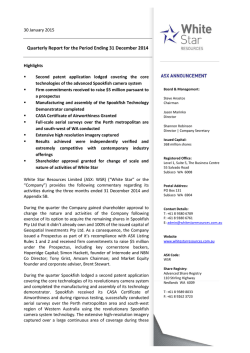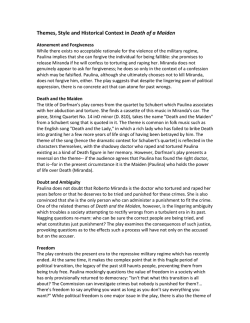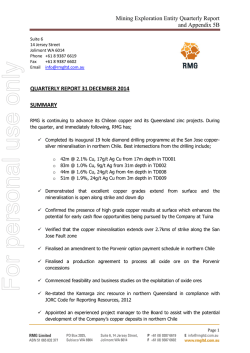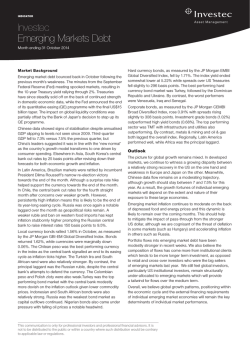
Chiles macroeconomic policy framework: Facing a changing world
Chile's macroeconomic policy framework: Facing a changing world Rodrigo Vergara Governor BANCO CENTRAL DE CHILE OCTOBER 2014 The Chilean economy: past and present 1990 2013 5,851 22,534 % of US 24 43 Poverty % of population 39 14 (*) Gini index 57 54 (*) External debt public (% of total) 56 6 private (% of total) 44 94 Trade (X+M) % of GDP 65 66 FDI (gross) % of GDP 2.1 7.3 Inflation (annual average of y-o-y; %) 26 1.8 Public debt (gross) % of GDP 44 12 Per capita GDP PPP (*) As of 2011, last available CASEN survey data. 2 Sources: World Bank, Central Bank of Chile, IMF, Social Development Ministry of Chile. Chile’s export matrix Total by sector (%) Manufacturing; 33 1990 Manufacturing; 35 Mining 57 Mining; 55 Agriculture; 12 Total by destination (%) 3 (*) Excluding China and Japan. Source: Central Bank of Chile. 2013 Agriculture; 8 1990 2013 Chile’s economic policy framework Four pillars of current economic policy framework 1. Inflation-targeting regime and a flexible exchange rate, administered by an autonomous Central Bank. 2. Responsible and predictable fiscal policy based on a rule that isolates expenditures from the business cycle. 3. A prudent regulatory and supervisory framework governing the financial system. 4. Integration into international markets. 5 ..but it was not always the case Annual Inflation and inflation target (%) Nonindependent 40 CB Independent CB Exchange rate band Capital controls Full-fledged inflation targeting Flex. exchange rate No capital controls 36 32 28 24 20 16 12 8 4 0 -4 85 87 89 91 93 95 97 99 01 03 05 07 09 11 13 15(f) 6 (f) Forecasts, Monetary Policy Report, September 2014. Sources: Central Bank of Chile and National Statistics Institute (INE). 40 36 32 28 24 20 16 12 8 4 0 -4 Why did we move to a flexible inflation- targeting regime? • Macroeconomic problems in EM have been often associated with: 1. Credit booms. 2. Real exchange-rate overvaluation 3. Large current-account deficits • The literature shows that those phenomena are more frequent in rigid currency regimes than in floating regimes, particularly during episodes of large capital inflows.* • In part because the extent of FX leverage, currency mismatches and foreign exchange loans in the banking and corporate sectors are significantly lower in floats than in less flexible regimes.▴ • And because the conduct of monetary and fiscal policies in rigid currency regimes during episodes of foreign capital bonanza tend to be pro-cyclical. * See, for instance, Mendoza and Terrones (2010), Ghosh, Ostry and Qureshi (2013). 7 ▴ Ghosh and others (2014); Jeanneau and Micu (2002). Why did we move to a flexible inflation- targeting regime? • During the recent Global Financial Crisis (GFC), ITers were able to implement more aggressive countercyclical monetary policies that allowed the exchange rate to absorb more of the adverse external shock, without a deterioration in their risk assessment by markets (Carvalho Filho, 2011). • Of course, in a financially integrated world it is not possible to insulate the economy from a the global financial cycle. • The experience during the 90's proved that capital controls did not have a big impact on the economy, that effects lasted mostly a short period and that with the exception of shifts in the composition from “short-term” debt inflows to “long-term” debt inflows, there were no other persistent effects. * * See, for instance, Gallego and others (2000), De Gregorio and others (2000). 8 The flexible exchange rate has become the main shock absorber CLP (*) CLP volatility (peso per US$ dollar) 750 750 35 35 Implicit in the price of CLP options 650 650 28 550 550 21 450 450 14 350 350 7 7 250 250 0 0 90 94 98 02 06 10 14 9 (%) 28 SD of daily changes 21 14 90 94 98 02 06 10 14 (*) An increase indicates a depreciation of the currency against the US$. The exchange rate bands are the upper and lower limits of a range inside which the exchange rate is allowed to float. This system operated until September 1999. Sources: Bloomberg and Central Bank of Chile. … allowing to carry out an independent monetary policy Monetary policy rates (%) 9 9 6 6 3 3 0 0 01 02 03 04 05 06 07 08 09 10 11 12 13 14 Chile 10 Sources: Central Bank of Chile and Bloomberg. FED Fed Fund Funds … coupled with a rule-based fiscal policy… Public sector balance (% of GDP) 9 9 6 6 Global financial crisis 3 0 0 -3 -3 -6 -6 00 02 04 06 Effective 08 10 Structural (f) Forecasts. Source: National Budget Department, Ministry of Finance of Chile. 11 3 12 14(f) … while keeping fiscal accounts in order and inflation expectations anchored. CPI inflation and expectations (*) Central government debt (annual change, %) (% of GDP) 20 20 10 10 0 0 -10 -10 -20 -20 00 02 04 06 08 10 12 Gross 12 Net 10 10 8 8 6 6 4 4 2 2 0 0 -2 -2 -4 -4 02 04 06 08 One year ahead CPI 10 12 14 Two years ahead (*) Economic Expectation Survey. Sources: Central Bank of Chile, National Statistics Institute (INE) and National Budget Department, Ministry of Finance of Chile. Sound financial system • In order to work properly, this policy framework requires a sound financial system. • In the case of Chile, the banking sector is characterized by good levels of capital and liquidity adequacy. 13 • Banking regulation is converging to Basel III standards. • The level of leverage is reasonable in both the household and the corporate sectors. • Dollarization is low. Chile’s adjustment to the current international cycle Global liquidity generated a massive increase in capital flows to emerging markets after the GFC. Capital flows to emerging markets (US$ billion, accumulated in 6 months) 250 250 200 200 150 150 100 100 50 50 0 0 -50 -50 06 07 08 09 Bond Source: Emerging Portfolio Fund Research. 15 10 11 12 Equity 13 14 That was reinforced by commodity prices that were at their highest historical levels. Commodity prices (index, 1990-2014=100) 300 300 250 250 200 200 150 150 100 100 50 50 0 0 90 92 WTI oil 16 94 96 98 Brent oil (1) Goldman Sachs aggregate index. Source: Bloomberg. 00 02 04 06 08 10 Agricultural products (1) 12 14 Copper After the “tapering talk” and China’s economy slowdown the game changed FX rates in emerging markets (*) Copper: Capex (annual change, %) 40 20 0 -20 17 (index, average of period=100) 40 140 140 140 140 20 120 120 120 120 0 100 100 100 100 -20 05-07 08-12 13 14 (f) 15 (f) 80 80 80 80 10 11 Chile Europe 12 13 14 Latin America Asia (f) Forecasts, financial information of producing companies. (*) PPP-weighted average for each region. An increase indicates a depreciation of the currency against the US$. Sources: Bloomberg and International Monetary Fund. …triggering an economic adjustment, after several years of above-potential growth GDP growth in Chile and the world (at PPP; annual change, %) Peak of mining investment boom, reconstruction, countercyclical policies from 2009 16 12 12 8 8 4 4 0 0 -4 -4 04 05 06 07 08 09 10 Emerging market and developing economies Emerging and developing Asia Chile 18 16 Sources: Central Bank of Chile and International Monetary Fund. 11 12 World LATAM 13 Chile's potential growth The monetary and fiscal policies are helping the economy to smooth this process. Long-term interest rates Real exchange rate (*) (%) 9 8 7 6 5 4 3 2 1 0 (index, 1986=100) 9 8 7 6 5 4 3 2 1 0 05 07 09 BCP-10 11 13 BCU-10 110 110 105 105 100 100 95 95 90 90 85 85 80 80 05 07 09 11 13 1999-2013 average 1994-2013 average 19 (*) An increase indicates a depreciation of the peso. Source: Central Bank of Chile. The FX has depreciated around 25% since last year and long-term interest rates have also declined. Nominal interest rates on 10-year gov. bonds FX depreciation (change since January 2, 2013, basis points) (change since January 2, 2013, %) Indonesia Israel Turkey Mexico Thailand Brazil Malaysia Russia Poland S. Africa Hungary Peru India Colombia Peru Mexico Czech Rep. India Colombia Malaysia Brazil Thailand Indonesia Chile Chile Czech Rep. Turkey Poland Russia Israel S. Africa -10 20 Hungary 0 10 20 30 40 Sources: Bloomberg and Central Bank of Chile. -200 0 200 400 The current account has improved. CAD, investment and national saving (% of GDP) 30 6 28 4 26 2 24 0 22 -2 20 -4 18 -6 03 04 05 06 07 Domestic saving Investment (*) 21 08 09 10 11 12 13 14 (f) External saving (CAD) (f) Forecast, Monetary Policy Report, September 2014 (*) Considers gross fixed capital formation and inventory adjustments. Sources: Central Bank of Chile, National Statistics Institute (INE). Inflation has increased, mostly because of peso depreciation. Inflation: headline and core (annual change, %) 5 5 4 4 3 3 2 2 1 1 0 0 12 Jul. 13 CPI Source: National Statistics Institute (INE). 22 Jul. CPIEFE 14 Jul. There are other things going on that explain why the slowdown has been more profound. Business confidence: IMCE (*) Consumer confidence: IPEC (*) (index) (index) 70 70 70 70 60 60 60 60 50 50 50 50 40 40 40 40 30 30 30 30 20 20 20 20 06 07 08 09 10 11 12 13 14 Manufacturing Commerce 23 06 07 08 09 10 11 12 13 14 Construction Total (*) A figure above (below) 50 points indicates optimism (pessimism). Seasonally-adjusted series. Sources:Adimark, Icare/Universidad Adolfo Ibáñez and Central Bank of Chile. Forecasts Economic outlook (annual change, %) 2012 2014 (f) 2015 (f) GDP 5.4 4.1 1.75-2.25 3.0-4.0 Domestic demand 6.9 3.4 0.1 3.4 Domestic demand (w/o inventory change) 7.1 4.2 1,0 3.2 12.2 0.4 -4.1 1.8 5.6 5.4 2.6 3.6 Goods and services exports 1.1 4.3 2.4 3.8 Goods and services imports 5.0 2.2 -3.9 4.0 Current account (% of GDP) -3.4 -3.4 -1.8 -2.2 Gross national saving (% of GDP) 21.7 20.5 19.8 19.7 Gross fixed capital formation Total consumption 24 2013 (f) Forecasts, Monetary Policy Report, September 2014. Source: Central Bank of Chile As it is always the case, there are some risks • Although growth in China and its outlook have stabilized most recently, its future performance is still a risk factor. • The macro-financial situation remains an element of uncertainty in the Eurozone, a situation that is compounded with the geopolitical tensions. • Global financial markets could suffer major episodes of stress when the Fed Funds rate begins to rise (or the markets to anticipate it). • In the local economy, one risk is growth of domestic output and demand being less than projected, because expectations do not reverse gradually, as is assumed in our baseline scenario. 25 • It cannot be ruled out that, at least temporarily, the effects of the exchange rate on inflation could delay the convergence of this variable. Chile's macroeconomic policy framework: Facing a changing world Rodrigo Vergara Governor BANCO CENTRAL DE CHILE OCTOBER 2014
© Copyright 2025





![View announcement [PDF 708.48 kB]](http://s2.esdocs.com/store/data/000465700_1-0b7c69c680e3fa00ddd1676cc9494343-250x500.png)